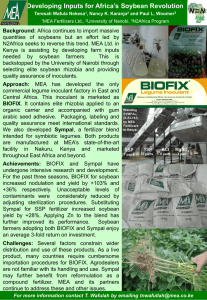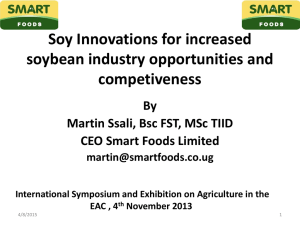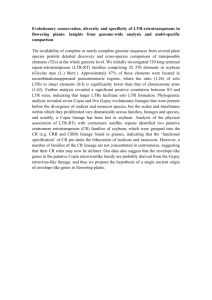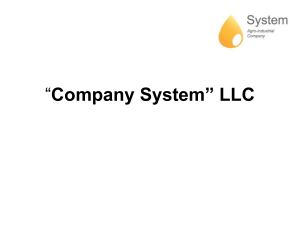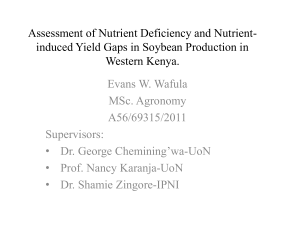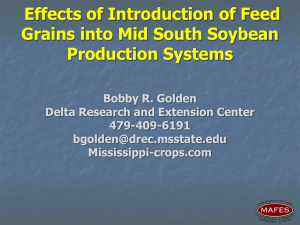PROJECT PROPOSAL SUMMARY - Virginia Soybean Association
advertisement
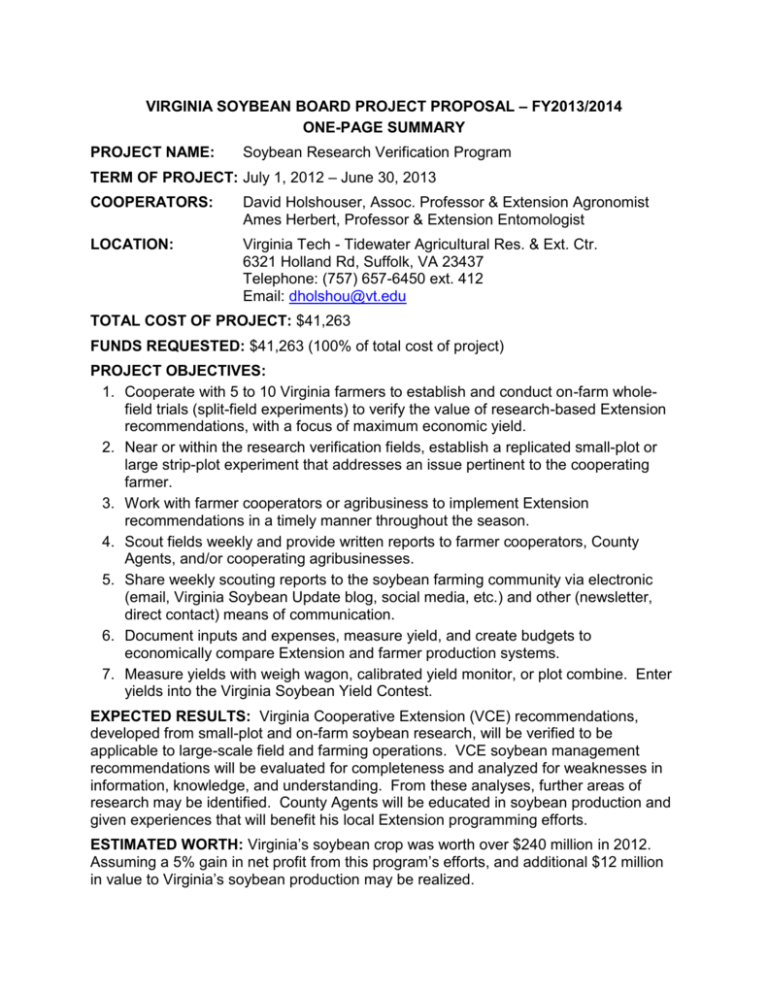
VIRGINIA SOYBEAN BOARD PROJECT PROPOSAL – FY2013/2014 ONE-PAGE SUMMARY PROJECT NAME: Soybean Research Verification Program TERM OF PROJECT: July 1, 2012 – June 30, 2013 COOPERATORS: David Holshouser, Assoc. Professor & Extension Agronomist Ames Herbert, Professor & Extension Entomologist LOCATION: Virginia Tech - Tidewater Agricultural Res. & Ext. Ctr. 6321 Holland Rd, Suffolk, VA 23437 Telephone: (757) 657-6450 ext. 412 Email: dholshou@vt.edu TOTAL COST OF PROJECT: $41,263 FUNDS REQUESTED: $41,263 (100% of total cost of project) PROJECT OBJECTIVES: 1. Cooperate with 5 to 10 Virginia farmers to establish and conduct on-farm wholefield trials (split-field experiments) to verify the value of research-based Extension recommendations, with a focus of maximum economic yield. 2. Near or within the research verification fields, establish a replicated small-plot or large strip-plot experiment that addresses an issue pertinent to the cooperating farmer. 3. Work with farmer cooperators or agribusiness to implement Extension recommendations in a timely manner throughout the season. 4. Scout fields weekly and provide written reports to farmer cooperators, County Agents, and/or cooperating agribusinesses. 5. Share weekly scouting reports to the soybean farming community via electronic (email, Virginia Soybean Update blog, social media, etc.) and other (newsletter, direct contact) means of communication. 6. Document inputs and expenses, measure yield, and create budgets to economically compare Extension and farmer production systems. 7. Measure yields with weigh wagon, calibrated yield monitor, or plot combine. Enter yields into the Virginia Soybean Yield Contest. EXPECTED RESULTS: Virginia Cooperative Extension (VCE) recommendations, developed from small-plot and on-farm soybean research, will be verified to be applicable to large-scale field and farming operations. VCE soybean management recommendations will be evaluated for completeness and analyzed for weaknesses in information, knowledge, and understanding. From these analyses, further areas of research may be identified. County Agents will be educated in soybean production and given experiences that will benefit his local Extension programming efforts. ESTIMATED WORTH: Virginia’s soybean crop was worth over $240 million in 2012. Assuming a 5% gain in net profit from this program’s efforts, and additional $12 million in value to Virginia’s soybean production may be realized. PROJECT PROPOSAL TO THE VIRGINIA SOYBEAN BOARD Title: Soybean Research Verification Program Cooperator: David Holshouser, Assoc. Professor & Extension Agronomist Ames Herbert, Professor & Extension Entomologist Virginia Tech – Tidewater AREC 6321 Holland Road Suffolk, VA 23437 (757) 657-6450 ext. 412 dholshou@vt.edu herbert@vt.edu Virginia Soybean Production Duration of Request: July 1, 2012 to June 30, 2013 Total Cost of Project: $41,263 Funds Requested: $41,263 (100% of total project cost) Mission and Objectives: The Soybean Research Verification Program in Virginia will represent a public display of the implementation of research-based Extension recommendations in an actual field scale farming environment. Information garnered from this project will help identify areas of production that need further study, improve existing Extension recommendations, and increase County Agent and crop adviser expertise in soybean production systems. The data collected from this project will be used to develop an on-farm database used for economic analysis and computer-assisted management programs. Specific objectives to accomplish this goal are listed below. 1. Cooperate with 5 to 10 Virginia farmers to establish and conduct on-farm whole-field trials (split-field experiments) to verify the value of research-based Extension recommendations, with a focus of maximum economic yield. 2. Near or within the research verification fields, establish a replicated small-plot or large strip-plot experiment that addresses an issue pertinent to the cooperating farmer. 3. Work with farmer cooperators or agribusiness to implement Extension recommendations in a timely manner throughout the season. 4. Scout fields weekly and provide written reports to farmer cooperators, County Agents, and/or cooperating agribusinesses. 5. Share weekly scouting reports to the soybean farming community via electronic (email, Virginia Soybean Update blog, social media, etc.) and other (newsletter, direct contact) means of communication. 6. Measure yields with weigh wagon, calibrated yield monitor, or plot combine. Enter yields into the Virginia Soybean Yield Contest. 7. Document inputs and expenses, measure yield, and create budgets to economically compare Extension and farmer production systems. D. Holshouser, Virginia Tech Significance of Project: Virginia’s 580,000 harvested acres of soybean are estimated to average 42 bushels per acre (USDA Agric. Statistics Service) resulting in production of 24.4 million bushels and worth over $292 million. This is a new record for yield and value. Virginia’s 20-year soybean trendline yield has increased from 26 to 36 bushels per acre, representing an annual increase of approximately 0.5 bushels per year. Some of this increase is due to new and improved varieties. However, official variety testing data indicate that improved management practices are responsible for at least half of the yield gains. To continue this yield improvement, soybean farmers must continue to adopt new and improved research-based practices. Although increasing yields is a priority, profitability is the aim for a sucessful operation. Any increase in yield must be more valuable than the cost of the input responsible for the additional yield. In many situations, additional inputs do not mean additional profits. Therefore, the overall goal of this project is to strive for maximum economic yield, not just yield. Profitability is necessary to a sustainable agricultural production system. Background, Prior and Current Research and Extension Efforts: The Virginia Soybean Board funds numerous research projects annually. While these projects always give valuable information and usually show a return on grower’s investment, implementing of and verification of this research is not always accomplished throughout Virginia. Usually the best method of widespread implementation of recommendations is to get a few key farmers to try the practice so to prove that the practice has merit on their operation. Once the research has been “verified” by several farmers, the further implementation of the project will spread through communication efforts within the agricultural community. This is basically the model for Cooperative Extension – “extending” knowledge for meaningful implementation and change. Virginia Soybean Board Proposal: Soybean Research Verification Program Page 2 D. Holshouser, Virginia Tech Research verification programs are not new. The Soybean Research Verification program in Arkansas is in its 29th year. The program is largely responsible for the double-digit yield improvements over the same time period. Information on Arkansas’ program can be found at www.aragriculture.org/soybean.htm. The Louisiana Soybean Research Verification Program (www.lsuagcenter.com/en/crops_livestock/crops/soybeans/lsrvp/) was established in 1994, where more than 125 fields in 20 parishes have been involved. Historically, the verification fields averaged 12 bushels more than the state average. Kentucky recently began a verification program in 2009 (www.uky.edu/Ag/GrainCrops/soybean.htm). In each year since, 16 fields across western Kentucky provided a direct comparison between the University of Kentucky recommendations and producer practices. Other states, including Virginia, have various versions of research verification programs. The multi-county Virginia On-Farm Soybean Test Plot program completed its 16th year in 2013. Those demonstration and research plots are an effort of VCE Agents and Specialists, area producers, and agribusiness to conduct on-farm tests that evaluate varieties, management practices, and new technologies. The goal is to provide researchbased non-biased information that enables farmers to make better management decisions. However, few efforts have included a side-by-side comparison of farmer- versus Extensionrecommended crop management systems. Plan of Work 1. Cooperate with 5 to 10 Virginia farmers to establish and conduct on-farm field trials (splitfield experiments) to verify the value of research-based Extension recommendations, with a focus of maximum economic yield. The first order of business will be to identify 5 to 10 Virginia farmers with the assistance of VCE Agents. A County Agent will be involved with no more than one farmer in this first year. This will help fulfill our goal of educating as many County Agents as possible on recommended soybean production practices. Once identified, we will sit down with the grower, County Agent, and/or crop adviser and go over his production practices, choose a verification field, determine what will be done in that field, and clearly establish each participant’s responsibilities. We will ask cooperators to agree to pay production expenses, provide crop expense data for economic analysis, and implement the recommended production practices in a timely manner. Our responsibilities will be soil and/or plant tissue sampling, weekly scouting, and measurement of yield. 2. Establish replicated small-plot or large strip-plot experiment that is of interest to farmer cooperator within the research verification field. We will establish a small-plot or large strip-plot experiment that tests a particular production practice. These experiments will be a simple two-treatment experiment comparing with or without a certain input or comparing two production practices such as notill versus in-row ripping as an example. Therefore, we will not only be evaluating the farmer’s overall soybean production system to our recommended practices, we will also increase our knowledge by gathering on-farm research data. 3. Work with farmer cooperators or agribusiness to implement Extension recommendations in a timely manner throughout the season. The initial meeting with the farmer, County Agent, and/or crop adviser will be followed up with another meeting before soybean planting. From a review of information presented in Virginia Soybean Board Proposal: Soybean Research Verification Program Page 3 D. Holshouser, Virginia Tech the initial meeting, we will establish our Extension recommendations and present them to the farmer. Alterations to this recommendation may be made at this time. However, the farmer and Extension practices will be clearly established at this time. Some recommendation will vary with week (e.g., insect spraying based on economic thresholds); therefore, recommendations will be updated based on weekly scouting reports. 4. Scout fields weekly and provide written reports to farmer cooperators, County Agents, and/or cooperating agribusinesses. Fields will be scouted by an employee chosen by Drs. Holshouser and Herbert. Preference will be given to a current or future student of the agricultural sciences. An internship with college students is a possibility. The employee will be intensively trained for scouting the fields by Drs. Holshouser and/or Herbert during their first few weeks of employment. Constant communication will be maintained during the week. The scout will complete written reports of the field each week and give a copy to the cooperating farmer, County Agent, and/or crop adviser. 5. Share weekly scouting reports to the soybean farming community via electronic (email, Virginia Soybean Update blog, social media, etc.) and other (newsletter, direct contact) means of communication. The weekly reports will be summarized at the end of each week. These summaries will be posted on the Virginia Soybean Update blog. The agricultural community will be notified of the summaries by email and social media. Fields included in the summaries will only be identified by the county and the cooperator’s name will not be revealed. 6. Measure yields with weigh wagon, calibrated yield monitor, or plot combine. Enter yields into the Virginia Soybean Yield Contest. Yield may be collected by measuring the field size and harvesting the entire field (or half-field) or by harvesting side-by-side strips of at least three acres. In these cases, a weigh wagon will be necessary to weigh the sample or to calibrate a yield monitor. A plot combine may also be used as long as the total measured area harvested equals three acres. These yields will be automatically entered in the annual Virginia Soybean Yield Contest, sponsored by the Virginia Soybean Association. 7. Document income, and expenses, and create budgets to economically compare Extension and farmer production systems. At the end of the growing season, VCE’s Enterprise Budget System Generator (BUDSYS) will be used to calculate net returns, cost of production ($/bu), and income. The results will be summarized and shared with the farmer, County Agent, and/or crop adviser. These enterprise budgets will remain confidential and not be shared with the general public. However, a summary budget report that will not identify the farm or county will be shared with Virginia soybean farmers as part of a year-end report. The year end report will summarize all locations and include a table containing the county, field size, previous crop, production system (full-season or double-crop), and other pertinent information such as variety, planting date , stand, harvest date, etc. Virginia Soybean Board Proposal: Soybean Research Verification Program Page 4 D. Holshouser, Virginia Tech Budget BUDGET CATEGORY FUNDS REQUESTED PERSONNEL (LABOR) Classified Staff (Ernest M. Ellis, 3 months) Classified Benefits (FY13/14 = 40.0%) Wage (TBA) Wage Benefits (FY013/14 = 7.75%) PERSONNEL (LABOR): SUB-TOTAL 11,632 4,653 $ 9,600 744 26,629 TRAVEL, CONVENTION, & EDUCATION Travel to and from plot and extension meetings; attend the 2012 American Society of Agronomy meetings and/or the 2013 Commodity Classic where results will be shared with colleagues and soybean farmers. 3,500 SUPPLIES AND MATERIALS Expendable field supplies, fuel, repair and maintenance 7,534 CONTRACTUAL SERVICES (Virginia Tech motor pool truck rental) 3,600 PROJECT TOTAL $ 41,263 *ONR negotiated rates for Virginia Tech The following personnel will be involved in this project: Dr. David L. Holshouser, Assoc. Professor & Extension Agronomist Ames Herbert, Professor & Extension Entomologist E. Michael Ellis, Agricultural Technician Sean Malone, Research Associate Wage Employee (TBA) Secretarial assistance Budget Justification: Salary and wage funds will be used to support farmer visits, planting and harvest of test plots, weekly scouting, and harvest of verification plots. Approximately 25% of an Agricultural Technician salary, 8% of a Research Associate salary, and 100% of the wage will be supported by these funds. Travel funds will be used to travel to and from verification fields, research plots, and extension meetings. Funds will also be used to attend the 2012 American Society of Agronomy meetings and/or the 2013 Commodity Classic where results will be shared with colleagues and soybean farmers. Material and supply funds will be used to purchase field supplies and fuel, and for vehicle and equipment repair and maintenance. Contractual services include funds to rent a vehicle from the Virginia Tech motor pool. Virginia Soybean Board Proposal: Soybean Research Verification Program Page 5 D. Holshouser, Virginia Tech Submitted by: Signature: Name: Dr. David Holshouser Title: Associate Professor, Tidewater AREC Institution: Virginia Polytechnic Institute & State University Virginia Soybean Board Proposal: Soybean Research Verification Program Page 6
